Yanwen Fan
AutoPruning for Deep Neural Network with Dynamic Channel Masking
Nov 02, 2020


Abstract:Modern deep neural network models are large and computationally intensive. One typical solution to this issue is model pruning. However, most current pruning algorithms depend on hand crafted rules or domain expertise. To overcome this problem, we propose a learning based auto pruning algorithm for deep neural network, which is inspired by recent automatic machine learning(AutoML). A two objectives' problem that aims for the the weights and the best channels for each layer is first formulated. An alternative optimization approach is then proposed to derive the optimal channel numbers and weights simultaneously. In the process of pruning, we utilize a searchable hyperparameter, remaining ratio, to denote the number of channels in each convolution layer, and then a dynamic masking process is proposed to describe the corresponding channel evolution. To control the trade-off between the accuracy of a model and the pruning ratio of floating point operations, a novel loss function is further introduced. Preliminary experimental results on benchmark datasets demonstrate that our scheme achieves competitive results for neural network pruning.
AIM 2020 Challenge on Real Image Super-Resolution: Methods and Results
Sep 25, 2020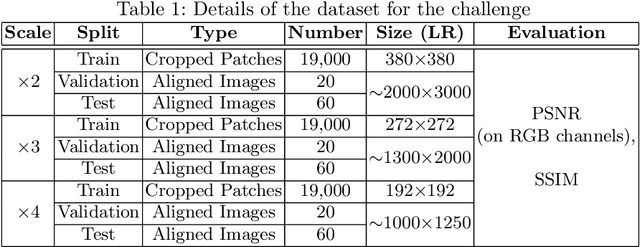
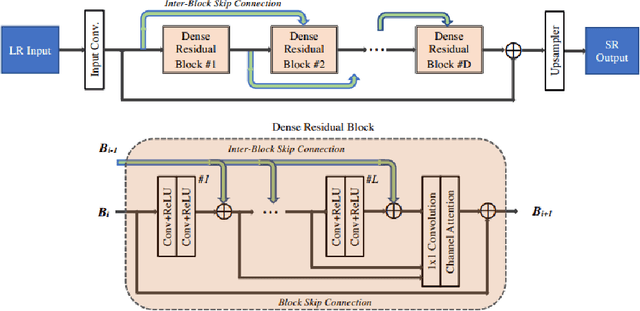
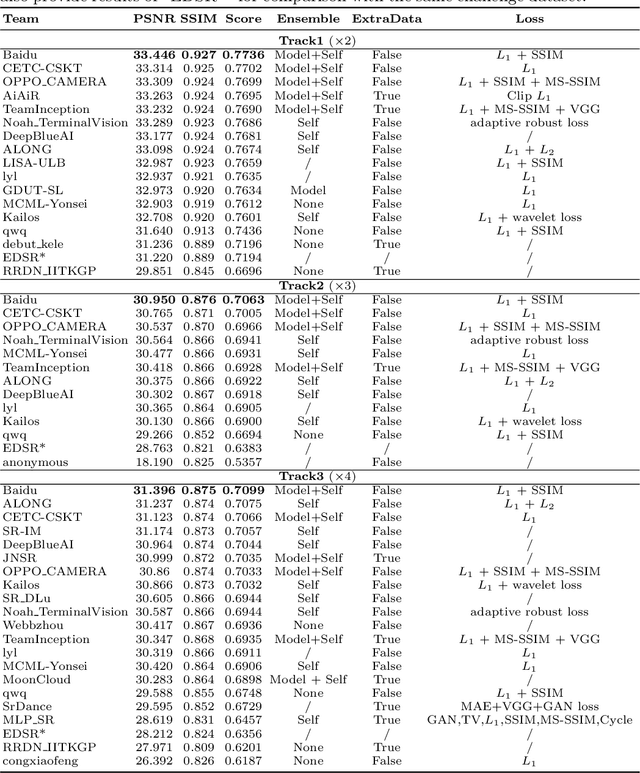
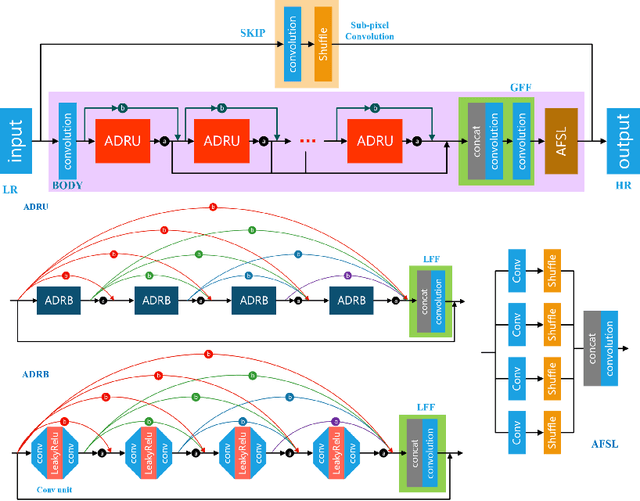
Abstract:This paper introduces the real image Super-Resolution (SR) challenge that was part of the Advances in Image Manipulation (AIM) workshop, held in conjunction with ECCV 2020. This challenge involves three tracks to super-resolve an input image for $\times$2, $\times$3 and $\times$4 scaling factors, respectively. The goal is to attract more attention to realistic image degradation for the SR task, which is much more complicated and challenging, and contributes to real-world image super-resolution applications. 452 participants were registered for three tracks in total, and 24 teams submitted their results. They gauge the state-of-the-art approaches for real image SR in terms of PSNR and SSIM.
Real Image Super Resolution Via Heterogeneous Model using GP-NAS
Sep 02, 2020



Abstract:With advancement in deep neural network (DNN), recent state-of-the-art (SOTA) image superresolution (SR) methods have achieved impressive performance using deep residual network with dense skip connections. While these models perform well on benchmark dataset where low-resolution (LR) images are constructed from high-resolution (HR) references with known blur kernel, real image SR is more challenging when both images in the LR-HR pair are collected from real cameras. Based on existing dense residual networks, a Gaussian process based neural architecture search (GP-NAS) scheme is utilized to find candidate network architectures using a large search space by varying the number of dense residual blocks, the block size and the number of features. A suite of heterogeneous models with diverse network structure and hyperparameter are selected for model-ensemble to achieve outstanding performance in real image SR. The proposed method won the first place in all three tracks of the AIM 2020 Real Image Super-Resolution Challenge.
NTIRE 2020 Challenge on Real Image Denoising: Dataset, Methods and Results
May 08, 2020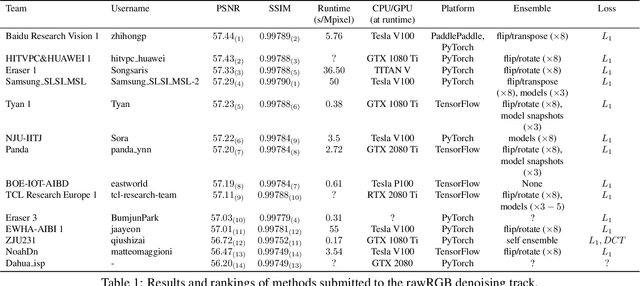
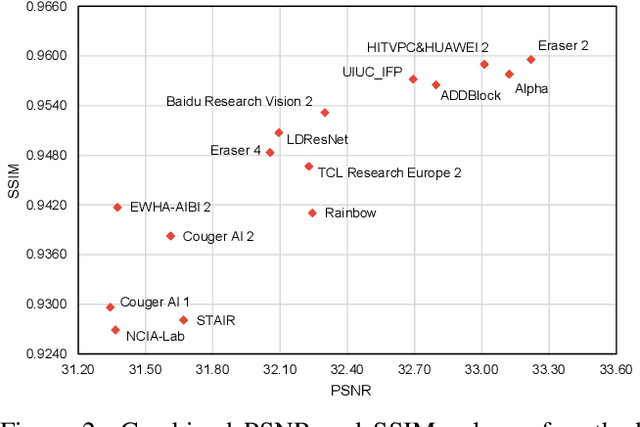
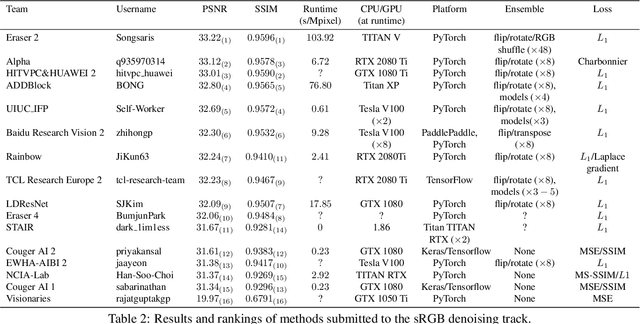
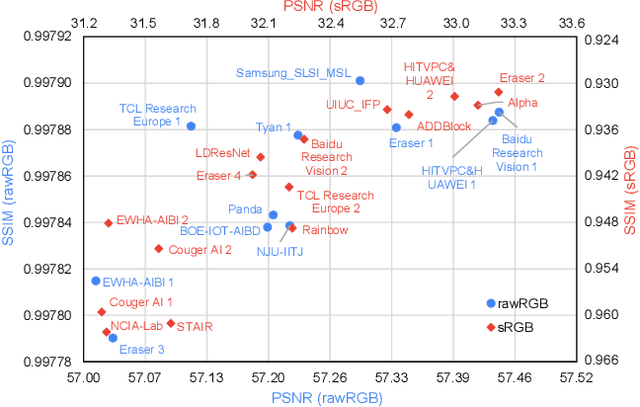
Abstract:This paper reviews the NTIRE 2020 challenge on real image denoising with focus on the newly introduced dataset, the proposed methods and their results. The challenge is a new version of the previous NTIRE 2019 challenge on real image denoising that was based on the SIDD benchmark. This challenge is based on a newly collected validation and testing image datasets, and hence, named SIDD+. This challenge has two tracks for quantitatively evaluating image denoising performance in (1) the Bayer-pattern rawRGB and (2) the standard RGB (sRGB) color spaces. Each track ~250 registered participants. A total of 22 teams, proposing 24 methods, competed in the final phase of the challenge. The proposed methods by the participating teams represent the current state-of-the-art performance in image denoising targeting real noisy images. The newly collected SIDD+ datasets are publicly available at: https://bit.ly/siddplus_data.
 Add to Chrome
Add to Chrome Add to Firefox
Add to Firefox Add to Edge
Add to Edge